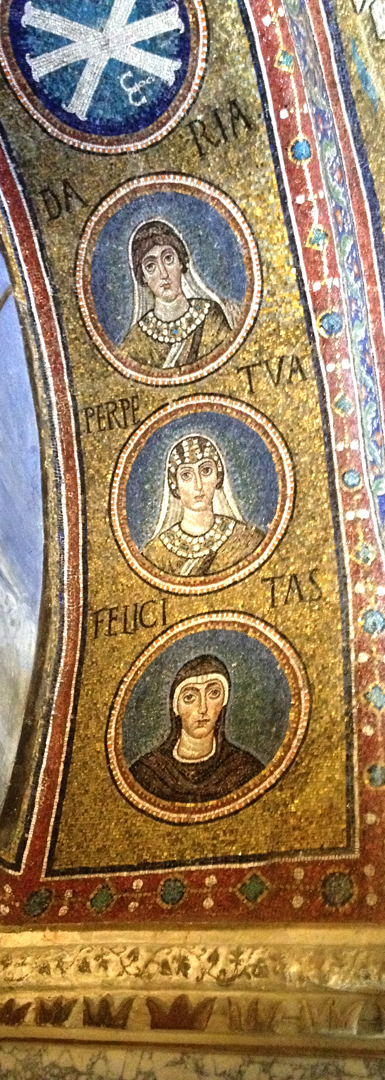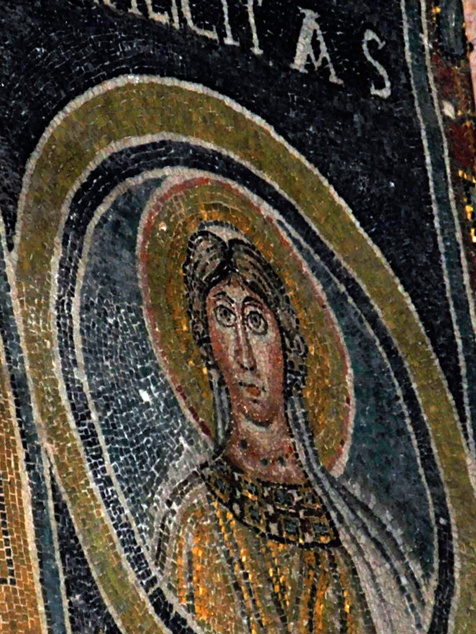The Passion tells most of the story in Perpetua's own voice. A small group of catechumens, including the noblewoman Perpetua and her servants Felicity and Revocatus, were imprisoned for their faith. Perpetua had a baby son who was still nursing, and Felicity was eight months pregnant. When Perpetua's father begged her to return to paganism for the sake of her family and her child she remained steadfast.
At last the group was taken to the amphitheatre to be exposed to the wild beasts as part of the games celebrating the Emperor's birthday. At first the women were sent out naked, but when the crowd protested they were given loose garments. When the beasts did not perform as expected, the Christians were put to the sword.
LATER RECEPTION AND REVISIONS OF THE STORY
In later years less attention was paid to the Passion, and portraits and narrative images from the second millenium are rare. The Golden Legend shoehorns their story into the chapter for St. Saturninus.The Legend, which clearly follows texts divergent from the Passion,3 also hardens the lines between Christian and pagan – suppressing, for example, the crowd's outrage when the two women are taken into the amphitheatre naked.
In the Passion Perpetua and her father are animated by a great fondness for each other despite their religious differences. But in the Legend when the parents take her son to her in prison "she put the little child from her, and them also, saying: 'Depart ye, and go ye from me, mine enemies, for I know you not.'"
In the Passion, Felicity prays for her baby daughter, who is born early so that she can entrust her to her sister, "rejoicing that she had borne a child in safety." But the Legend suppresses every trace of this solicitude for the child. On the other hand, while the Passion is silent about her husband the Legend has her say, "I have one, but I set not by him."4
The people of Carthage are also harder of heart in the Legend than in the Passion. There is no mention of their outrage at the women's being brought out naked, nor of the mutual affection between the Christians and their jailer Pudens.
NARRATIVE IMAGES
The amphitheatre figures in one of the narrative images I have seen and possibly this one as well. In another case, the final execution of the martyrs by the sword is done outside the city. Perhaps this reflects a misunderstanding of the "gates" mentioned in the Passion, which were not the gates of the city but the arena's Porta Sanavivaria and Porta Libitinensis – the "Gate of Life" reserved for victorious gladiators and the "Funeral Gate" through which the corpses of the others were removed.5 Or it may reflect one of the variant legends that place the deaths in the city of Thuburbo Minus (modern Tebourba).6PORTRAITS
Typical of the earliest images, the mosaics at right lack attributes, although the one from Ravenna does put Felicity in plainer garments to remind the viewer that she was a slave. In second-millenium images the two saints hold long swords pointed down, referring to the manner of their execution (example).Prepared in 2013 by Richard Stracke, Emeritus Professor of English, Augusta University. Revised 2016-12-19.

Archiepiscopal Museum, Ravenna, 6th century (See the description page)

Euphrasian Basilica, Poreč (Croatia), 6th century (See the description page)
ATTRIBUTES
- Long swords pointing down
DATES
- According to the "Passion" Perpetua died at age 22 during the reign of Geta Augustus (209-211).
- Traditional date of death, accepted by Butler (498): 203.
- Date claimed by the Golden Legend (which does not give her age): 256.
- The March 7 feast day was later given to Thomas Aquinas, with Perpetua and Felicity moved to March 6.
BIOGRAPHY
- Perpetua and Felicity's story is told within the Golden Legend's account of the three saints named Saturninus, , chapter 173.
- "The Passion of SS. Perpetua and Felicitas": online at the Internet Medieval Sourcebook; in print in Stouck, 21-32.
- "Augustine Preaches on the Feast of SS. Perpetua and Felicitas," Stouck, 39-42.
- Critical overview of translations and editions: Butler, 498.
- Acta Sanctorum, March vol. 1, 630-38.
- Carolus de Smedt et al., "Un nouveau Manuscrit des Actes des Saintes Félicité et Perpétue," Analecta Bollandiana, XI, 369-73.
NOTES
1 Butler, 493.
2 Wikipedia, s.v. "Litany of the Saints" (retrieved 2013-11-29).
3 Like Bede (Stouck, 102) and several versions examined in the Acta Sanctorum (March vol. 1, 629-30), the Legend has the martyrs killed by beasts, not by the sword. There is also some divergence among the sources regarding where and when they died.
4 So Caxton. Graesse has habeo sed contemno; Ryan, "Yes, but I have nothing to do with him."
5 Bomgardner, 137.
6 Acta Sanctorum, ibid., 631-32.